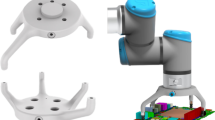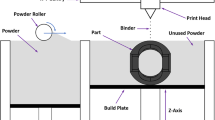Abstract
Different industries are adopting additive manufacturing (AM) technologies to produce complex designs with minimum material wastage. The sustainability assessment of AM technologies is therefore essential to address the current environmental challenges. This research aims to compare the environmental impacts of different raw materials used for the production of a robot end-effector with internal conformal channels via powder bed fusion (PBF) and provide a framework to assess the sustainability of polymer, metal, and composite-based materials selected for this technology. A life cycle assessment (LCA) was performed comparing the production of a robot end-effector using three different raw materials, i.e., Polyamide 12 (PA12), aluminum alloy powder AlSi10Mg, and a composite of PA12 and graphene nanoplatelets (to induce electrostatic-dissipative properties for attaining functionality of picking and placing printed circuit boards) via PBF technology. Selective laser sintering (SLS) and direct metal laser sintering (DMLS) processes were considered to produce the robot end-effector. The scope was cradle-to-gate, including raw material extraction, transportation, transformation during manufacturing, and corresponding energy utilization. Environmental impact assessment categories are divided into air, water, and land emissions. These include global warming (GW), stratospheric ozone depletion (SOD), fine particulate matter formation (FPMF), water consumption (WC), freshwater ecotoxicity (FWT), freshwater eutrophication (FWE), fossil resource scarcity (FRS), land use (LU), terrestrial acidification (TA), and terrestrial ecotoxicity (TE). Three different raw materials used to produce robot end-effectors were compared using the ReCiPe Midpoint (H) impact assessment methodology. According to the results, the production of the robot end-effector using PA12 had the lowest environmental impact. Electricity consumption during the PBF and the production of raw materials were the overall major contributors to the selected environmental impact categories. A generic framework to assess the environmental performance of materials used for PBF is proposed. A detailed cradle-to-gate LCA is performed to highlight the environmental hotspots of PBF technology and ways to improve the environmental performance of AM in general.


















Similar content being viewed by others
Data availability
All data generated or analyzed during this study are included in this published article and are also available with the supplementary information files.
References
Arif ZU, Khalid MY, Tariq A, Hossain M, Umer R (2023) 3d printing of stimuli-responsive hydrogel materials: Literature review and emerging applications. Giant. https://doi.org/10.1016/j.giant.2023.100209
Ashby MF (2012) Materials and the environment: eco-informed material choice. Elsevier. https://doi.org/10.1016/b978-0-12-385971-6.00010-5
Bala A, Raugei M, Benveniste G, Gazulla C, Palmer P (2010) Simplified tools for global warming potential evaluation when good enough is best. Int J Life Cycle Assess 15:489–498. https://doi.org/10.1007/s11367-010-0153-x
Bourhis F, Kerbrat O, Dembinski L, Hascoet J, Mognol P (2014) Predictive model for environmental assessment in additive manufacturing processes. CIRP Conf Life Cycle Eng. https://doi.org/10.1016/j.procir.2014.06.031
De Bann L, Alkemade R, Köllner T (2013) Land use impacts on biodiversity in lca:a global approach. Int J Life Cycle Assess 18:1216–1230. https://doi.org/10.1007/s11367-012-0412-0
Frischknecht R, Rebitzer G (2005) The ecoinvent database system: a comprehensive web-based LCA database. J Clean Prod 13:1337–1343. https://doi.org/10.1016/j.jclepro.2005.05.002
Han D, Lee H (2020) Recent advances in multimaterial additive manufacturing: methods and applications. Curr Opin Chem Eng 28:158–166. https://doi.org/10.1016/j.coche.2020.03.004
He D, Kim H, Kleine R, Soo V, Kiziltas A, Compston P, Doolan M (2022) Life cycle energy and greenhouse gas emissions implications of polyamide-12 recycling from selective laser sintering for an injection-molded automotive component. J Ind Ecol 26:1378–1388. https://doi.org/10.1111/jiec.13277
Heijungs R (2020) On the number of Monte Carlo runs in comparative probabilistic LCA. Int J Life Cycle Assess 25:394–402. https://doi.org/10.1007/s11367-019-01698-4
Helmes R, Huijbregts M, Henderson A (2012) Spatially explicit fate factors of phosphorus emissions to freshwater at the global scale. Int J Life Cycle Assess 17:646–654. https://doi.org/10.1007/s11367-012-0382-2
Hoekstra A, Mekonnen M (2012) The water footprint of humanity. Environ Sci 109:3232–3237. https://doi.org/10.1073/pnas.1109936109
Huijbregts M, Steinmann Z, Elshout P, Stam G, Verones F, Vieira M, Van Zelm R (2017) ReCiPe2016: a harmonised life cycle impact assessment method at midpoint and endpoint level. Int J Life Cycle Assess 22:138–147. https://doi.org/10.1007/s11367-016-1246-y
Ji Q, Zhang J, Liu Y, Li Y, Lv P, Jin D, Duan H (2018) A modular microfluidic device via multimaterial 3D printing for emulsion generation. Sci Rep 8:1–11. https://doi.org/10.1038/s41598-018-22756-1
Jungbluth N, Frischknecht R (2010) Cumulative energy demand. In: Hischier R, Weidema B (eds) Implementation of life cycle impact assessment methods. Ecoinvent center
Khalid MY, Arif ZU, Tariq A, Hossain M, Khan KA, Umer R (2024) 3d printing of magneto-active smart materials for advanced actuators and soft robotics applications. Eur Polym J 205:112718. https://doi.org/10.1016/j.eurpolymj.2023.112718
Kokare S, Oliveira J, Godina R (2023) A lca and lcc analysis of pure subtractive manufacturing, wire arc additive manufacturing, and selective laser melting approaches. J Manuf Process 101:67–85. https://doi.org/10.1016/j.jmapro.2023.05.102
Kokare S, Oliveira J, Godina R (2023) Life cycle assessment of additive manufacturing processes: A review. J Manuf Syst 68:536–559. https://doi.org/10.1016/j.jmsy.2023.05.007
Kokare S, Oliveira J, Santos T, Godina R (2023) Environmental and economic assessment of a steel wall fabricated by wire-based directed energy deposition. Addit Manuf 61:103316. https://doi.org/10.1016/j.addma.2022.103316
Li F, Macdonald N, Guijt R, Breadmore M (2019) Increasing the functionalities of 3D printed microchemical devices by single material, multimaterial, and print-pause-print 3D printing. R Soc Chem 19:35–49. https://doi.org/10.1039/c8lc00826d
Loke G, Yuan R, Rein M, Khudiyev T, Jain Y, Joannopoulos J, Fink Y (2019) Structured multi material filaments for 3D printing of optoelectronics. Nat Commun 10:1–10. https://doi.org/10.1038/s41467-019-11986-0
London M, Lweis G, Keoleian G (2020) Life cycle greenhouse gas implications of multi jet fusion additive manufacturing. ACS Sustain Chem Eng 8:15595–15602. https://doi.org/10.1021/acssuschemeng.0c04845
Lopes AC, Sampaio AM, Fernandes F, Vaz PM, Pontes AJ (2023) Design and industrial implementation of a multi-functional part produced by powder bed fusion. Progress Addit Manuf. https://doi.org/10.1007/s40964-023-00493-w
Mehrpouya M, Tuma D, Vanekar T, Afrasiabi M, Bambach M, Gibson I (2022) Multimaterial powder bed fusion techniques. Rapid Prototyp J 28:1–19. https://doi.org/10.1108/RPJ-01-2022-0014
Molotnikov A, Kingsbury A, Brandt M (2021) Current state and future trends in laser powder bed fusion technology. Addit Manuf Mater Technol 4:621–634. https://doi.org/10.1016/B978-0-12-824090-8.00011-1
Ochs D, Wehnert K, Hartmann J, Schiffler A, Schmidtt J (2021) Sustainable aspects of a metal printing process chain with laser powder bed fusion (lpbf). CIRP Conf Life Cycle Eng. https://doi.org/10.1016/j.procir.2021.01.163
Peng T, Wang Y, Zhu Y, Yang Y, Yang Y, Tang R (2020) Life cycle assessment of selective-laser-melting-produced hydraulic valve body with integrated design and manufacturing optimization: A cradle-to-gate study. Addit Manuf 36:101530. https://doi.org/10.1016/j.addma.2020.101530
Polychronopoulos ND, Vlachopoulos J (2020) The role of heating and cooling in viscous sintering of pairs of spheres and pairs of cylinders. Rapid Prototyp J 26(4):719–726. https://doi.org/10.1108/rpj-06-2019-0162
Priarone P, Lunetto V, Atzeni E, Salmi A (2018) Ilaser powder bed fusion (L-PBF) additive manufacturing: On the correlation between design choices and process sustainability. Paper presented at the 6th CIRP Global Web Conference Ënvisaging the future manufacturing, design, technologies, and systems in innovation era. Proced Cirp 78:85–90
Rafiee M, Farahani RD, Therriault D (2020) Multi-material 3d and 4d printing: a survey. Adv Sci 7(12):1902307. https://doi.org/10.1002/advs.201902307
Ribeiro I, Matos F, Jacinto C, Salman H, Cardeal G, Carvalho H, Peças P (2020) Framework for life cycle sustainability assessment of additive manufacturing. Sustainability. https://doi.org/10.3390/su12030929
Roux C, Kuzmenko K, Roussel N, Mesnil R, Feraille A (2023) Life cycle assessment of a concrete 3D printing process. Int J Life Cycle Assess 28:1–15. https://doi.org/10.1007/s11367-022-02111-3
Roy P, Azevedo L, Margni M, Van Zelm R, Deschenes L, Huijbregts M (2014) Characterization factors for terrestrial acidification at the global scale: a systematic analysis of spatial variability and uncertainty. Sci Total Environ 500:270–276. https://doi.org/10.1016/j.scitotenv.2014.08.099
Schmidt M, Thorne P, Engström U, Gabler J, Jesberger T, Feldbauer S (2004) Effect of sintering time and cooling rate on sinter hardenable materials. PM2 TEC 1–12
Soreni-Harani M, St. Pierre R, McCue C, Moreno K, Bergbreiter S (2020) Multimaterial 3D Printing for Microrobotic Mechanisms. Soft Robot . https://doi.org/10.1089/soro.2018.0147
Sreenivasan R, Bourell D (2009) Sustainability study in selective laser sintering - an energy perspective. Paper presented at 2009 International Solid Freeform Fabrication Symposium
Sun S, Brandt M, Easton M (2017) Powder bed fusion processes: an overview. Laser Addit Manuf. https://doi.org/10.1016/B978-0-08-100433-3.00002-6
Van Zelm R, Preiss P, Van Goethem T, Van Dingenen R, Huijbregts M (2016) Regionalized life cycle impact assessment of air pollution on the global scale: damage to human health and vegetation. Atmos Environ 134:129–137. https://doi.org/10.1016/j.atmosenv.2016.03.044
Vock S, Klöden B, Kichner A, Weißgäber T, Kieback B (2019) Powders for powder bed fusion: a review. Addit Manuf 4:383–397. https://doi.org/10.1007/s40964-019-00078-6
Wang HF, Geng BQ, Guo HG, Zheng YF, Yu QB, Ge C (2020) The effect of sintering and cooling process on geometry distortion and mechanical properties transition of ptfe/al reactive materials. Def Technol 16(3):720–730. https://doi.org/10.1016/j.dt.2019.10.006
Wernet G, Bauer C, Steubing B, Reinhard J, Ruiz E, Weidema B (2016) The ecoinvent database version 3 (part i): overview and methodology. Int J Life Cycle Assess 21:1218–1230. https://doi.org/10.1007/s11367-022-02129-7
WMO (2011) Scientific assessment of ozone depletion: 2010, Global Ozone Research and Monitoring. Project-report no.52. World Meteorological Organization, Geneva
Zhang Y, Ng C, Chen Z, Zhang W, Panjwani S, Kowsari K, Ge Q (2019) Miniature pneumatic actuators for soft robots by high-resolution multimaterial 3D printing. Adv Mater Technol 4:1900427. https://doi.org/10.1002/admt.201900427
Funding
This research was funded by National Funds through FCT - Portuguese Foundation for Science and Technology (PhD scholarships SFRH/BD/144590/2019 and 2020.04520.BD) and by DTx -Digital Transformation Colab (ref. NORTE-59-2018-41), supported under the Northern Regional Operational Programme (NORTE2020) and the European Social Fund.
Author information
Authors and Affiliations
Corresponding author
Additional information
Publisher's Note
Springer Nature remains neutral with regard to jurisdictional claims in published maps and institutional affiliations.
Supplementary Information
The supplementary files containing life cycle impact assessment results and uncertainty analysis results are available and attached as separate files.
Rights and permissions
Springer Nature or its licensor (e.g. a society or other partner) holds exclusive rights to this article under a publishing agreement with the author(s) or other rightsholder(s); author self-archiving of the accepted manuscript version of this article is solely governed by the terms of such publishing agreement and applicable law.
About this article
Cite this article
Anwar, T., Lopes, A.C., Silva, E.C. et al. Cradle-to-gate life cycle assessment: a comparison of polymer and metal-based powder bed fusion for the production of a robot end-effector with internal conformal channels. Prog Addit Manuf (2024). https://doi.org/10.1007/s40964-024-00640-x
Received:
Accepted:
Published:
DOI: https://doi.org/10.1007/s40964-024-00640-x




